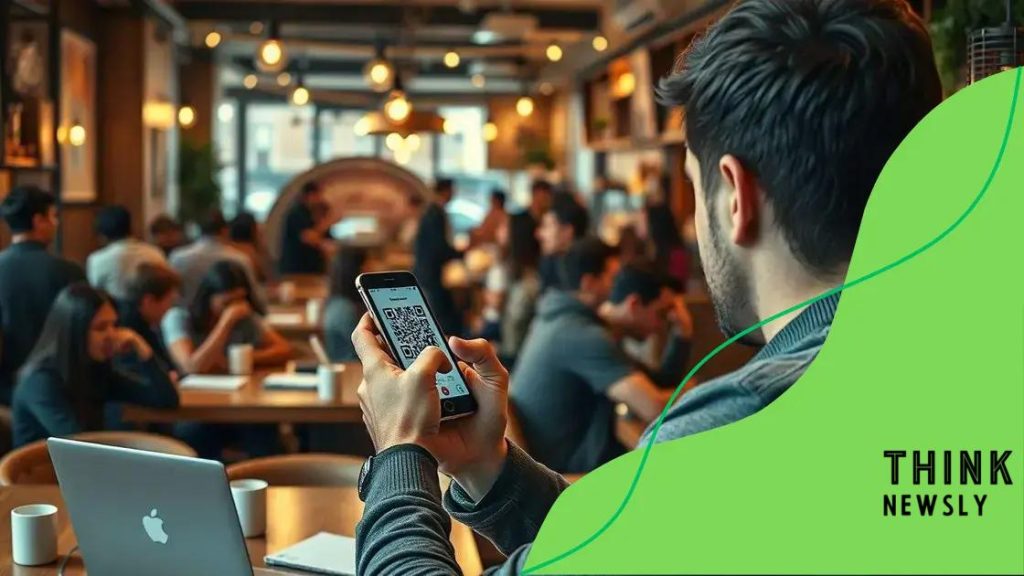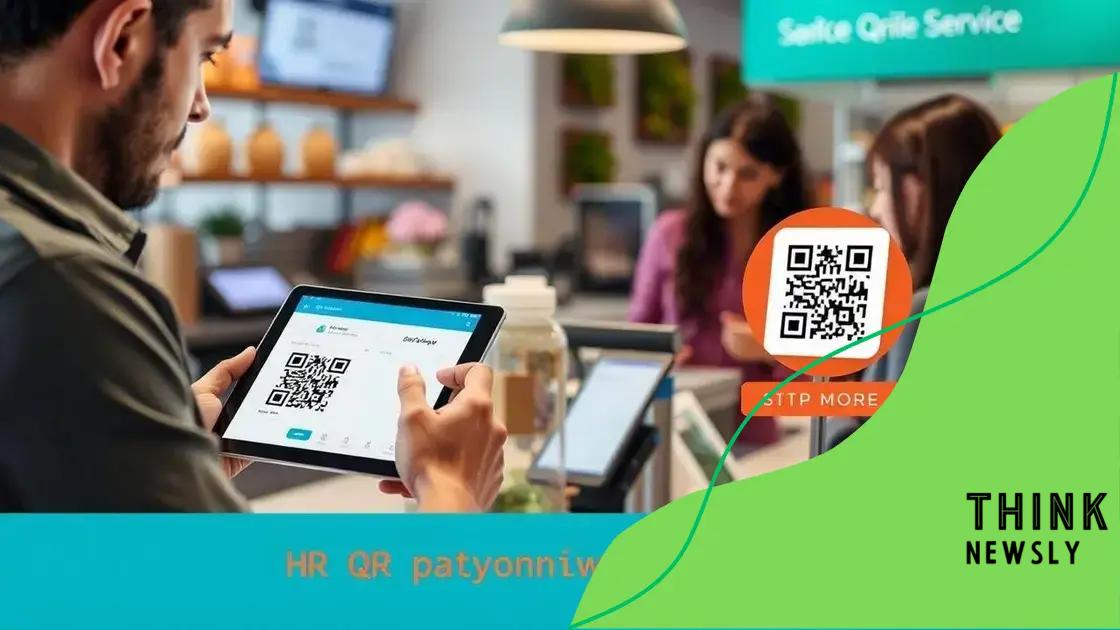QR pay spreads fast: the future of payment processing

Anúncios
QR payment systems enable fast and secure transactions through the scanning of QR codes, offering convenience for consumers and businesses alike, while enhancing user experience and reducing transaction times.
QR pay spreads fast across various platforms, changing the way we handle transactions. Have you noticed how quickly people are opting for QR codes? Let’s dive into this movement!
Anúncios
Understanding QR pay technology
Understanding QR pay technology is essential for anyone looking to adapt to the fast-paced world of digital payments. It’s a system that simplifies transactions using QR codes scanned by smartphones. This method is quickly becoming popular worldwide.
What Is QR Pay?
QR pay utilizes Quick Response (QR) codes that store payment information. Users can scan these codes with their smartphones, making transactions quick and easy. This eliminates the need for cash or physical cards.
Key Benefits
Here are some advantages of using QR payments:
Anúncios
- Quick and easy transactions.
- Enhanced security features.
- Contactless payment options.
- Widespread accessibility through smartphones.
This technology improves the customer experience significantly. Scanning a QR code is often faster than traditional payment methods. As businesses adopt these systems, more consumers appreciate the convenience.
How Does It Work?
A QR code is generated when a merchant sets up their payment service. Customers then scan the code with their phones, which directs them to a payment portal. They can securely complete their payment in just a few taps. This process helps businesses save time and reduce long queues.
Furthermore, the ease of use is a major reason QR pay is spreading rapidly. Imagine being able to buy your morning coffee with a quick scan instead of fumbling for cash or searching for your card. Such convenience has become a significant selling point for consumers.
Benefits of using QR payments
Exploring the benefits of using QR payments reveals why this technology is gaining traction. More businesses and consumers appreciate its advantages in today’s digital landscape. This payment method not only enhances convenience but also offers a host of practical benefits.
Convenience and Speed
One significant advantage of QR payment is its speed. Customers can complete transactions in just a few seconds. Instead of waiting for card processing, they simply scan and pay. This quick process reduces long lines and improves overall customer satisfaction.
Enhanced Security
Security is another area where QR payments excel. These transactions use encryption technology, ensuring that users’ financial information remains safe. As consumers become more aware of security issues, the use of secure QR codes builds trust in the payment process.
- Information is encrypted for security.
- Less risk of fraud compared to card swiping.
- Immediate transaction confirmation provides peace of mind.
- Minimal physical contact reduces health risks.
Moreover, QR payments are incredibly user-friendly. Most people already own smartphones capable of scanning QR codes. This eliminates the need for complex training or equipment for both businesses and customers. Just scan, enter the amount, and confirm.
Cost-Effective Solutions
Businesses benefit from reduced transaction costs when adopting QR payment systems. Unlike traditional payment methods that incur hefty fees, QR payments often have lower processing fees. This is especially advantageous for small businesses looking to save on operational costs.
In addition, since QR payments can be integrated into existing payment systems, businesses don’t need to invest in new hardware. This flexibility allows them to implement a payment solution without a significant financial burden.
How to integrate QR pay into businesses

Integrating QR pay into businesses can enhance customer experiences and streamline transactions. It’s a straightforward process that can be achieved with the right steps and tools. Understanding how to effectively implement this payment system is crucial for modern businesses.
Choosing the Right QR Payment System
The first step in integrating QR pay is selecting a payment provider that meets your business needs. Look for services that offer user-friendly interfaces and reliable customer support. Many options also provide competitive transaction rates.
- Research available platforms.
- Compare fees and features.
- Read reviews from other businesses.
- Evaluate integration capabilities.
Once you choose a provider, setting up an account is usually quick and involves providing basic business information. This process helps maintain secure connections for processing transactions.
Creating QR Codes
After establishing your account, the next step is creating QR codes. Most payment platforms offer tools for generating unique codes for different products or services. Simply input the necessary details, such as the price or a product description.
These codes are typically easy to customize, allowing businesses to include logos or design elements. This not only enhances branding but also makes the payment experience visually appealing for customers.
Displaying QR Codes
Once the QR codes are ready, it’s essential to display them in strategic locations. Place them prominently at checkout areas or on marketing materials. Customers should easily see and access these codes while making purchases.
Integrating QR payments also involves staff training. It is vital for employees to understand how to assist customers in using the codes. This support can lead to a smoother transaction process and enhance customer satisfaction. Encourage staff to practice scanning and troubleshooting common issues.
Testing and Feedback
After integration, conducting tests is important. Ensure that the payment process works smoothly from the customer’s perspective. Encourage employees to provide feedback on the integration process and address any concerns they might have. This proactive approach can highlight areas for improvement.
As customers begin to use QR pay, gathering their feedback also helps. Listening to customer experiences will allow businesses to make necessary adjustments, ensuring the payment method is truly convenient and efficient.
Consumer behavior and QR payments
Understanding consumer behavior and QR payments is essential for businesses aiming to leverage this growing trend. As digital payments continue to evolve, knowing how customers react to QR codes can enhance user experience and boost sales.
Shift Toward Digital Payments
More consumers are moving away from cash transactions. This shift has made QR payments increasingly popular, especially among younger generations who prefer mobile solutions. They appreciate the convenience and speed that comes with this method.
Ease of Use
One of the significant factors influencing consumer behavior is the ease of use of QR payments. Users find it simple to scan codes with their smartphones, making the checkout process faster than traditional methods. This simplicity encourages more customers to choose QR payments over other options.
- Quick transactions save time.
- Minimal steps required to make a payment.
- Less chance of errors compared to entering card details.
Consumers enjoy having a straightforward payment process. The less complicated it is, the more likely they are to use it again in the future. When businesses provide seamless QR payment options, they can attract and retain more customers.
Security Concerns
Another aspect of consumer behavior is the concern for security. Many customers worry about the safety of their financial data. However, QR payments usually incorporate encryption, which helps to alleviate these concerns. As awareness of security features increases, consumers are more inclined to trust and use these digital payment methods.
Moreover, QR payments facilitate contactless transactions, which many people prefer, especially in today’s health-conscious environment. This feature not only enhances safety but also significantly influences consumer choices.
Influence of Marketing
Consumers are also influenced by how businesses promote QR payments. Effective marketing strategies can encourage customers to embrace this payment method. Promotions offering discounts or rewards for using QR codes can drive consumer interest, making them more willing to adopt this new technology.
Businesses can further enhance consumer behavior by providing clear instructions on how to use QR payments. This guidance can help ease any apprehensions and encourage customers to try this convenient payment method.
Future trends of QR payment systems
The future trends of QR payment systems are promising and indicate a significant shift in how transactions will be conducted. As technology evolves, we can expect more innovation in the ways consumers and businesses interact through digital payments.
Increased Adoption of Contactless Payments
One prominent trend is the rise in contactless payments. Consumers appreciate the convenience and safety of using their smartphones to make purchases effortlessly. This transition will likely encourage more businesses to adopt QR payment methods, as they provide a frictionless checkout experience.
Enhanced Security Features
Security is a major concern for both consumers and businesses. As QR payment systems become more mainstream, we can expect enhanced security features. These may include advanced encryption, biometric authentication, and two-factor authentication. Such improvements will likely build trust among users, encouraging broader adoption.
- Integration of biometric authentication for added security.
- Use of blockchain technology to secure transactions.
- Improved fraud detection mechanisms.
With these advancements, consumers will feel more confident using QR payments, knowing their information is safeguarded.
Integration with Loyalty Programs
Another trend is the integration of QR payments with loyalty and rewards programs. Businesses can leverage these systems to offer customers discounts, points, or cashback directly through the payment process. This not only enhances user engagement but also boosts customer loyalty.
As more companies recognize the value of providing benefits through QR payments, the combination of convenience and incentives will attract a more extensive user base.
Expansion in Emerging Markets
Emerging markets will also see a surge in QR payment adoption. In regions where traditional banking infrastructure is limited, QR codes provide a viable solution for making transactions easier. Mobile wallets linked to QR payment systems can facilitate financial inclusion for underserved populations.
As smartphone penetration increases in these markets, we can expect significant growth in QR payment usage, contributing to a global shift towards digital transactions.
Innovative Use Cases
We will likely see innovative use cases for QR payments beyond traditional retail. Future applications may include areas like ticketing for events, in-app purchases for digital content, and even cross-border payments without high fees. These developments will create even more opportunities for businesses and consumers alike.
As technology continues to evolve, the future of QR payment systems looks bright, shaping how we conduct transactions in everyday life.
FAQ – Frequently Asked Questions about QR Payment Systems
What are QR payment systems?
QR payment systems allow users to pay for goods and services by scanning a QR code with their smartphones, making transactions quick and convenient.
How secure are QR payments?
QR payments typically use encryption and other security features to protect users’ financial information, making them a secure method of payment.
Why should businesses adopt QR payment systems?
Adopting QR payment systems can enhance customer experience, reduce transaction times, and often incur lower fees compared to traditional payment methods.
Are QR payments popular among consumers?
Yes, QR payments are becoming increasingly popular, especially among younger consumers who prefer contactless and convenient payment solutions.





